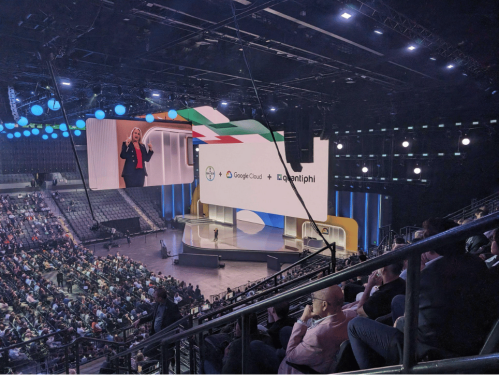In these situations, I can usually fake my way through it, misdirect, or evade it with humor. I’ve done this my whole life and I’ve gotten pretty good at it. Have you ever been on a team where one or two people do most of the talking? Trick question! Of course you have. We all have.
If you look around, you’ll likely see someone who looks like they are just about to say something, but never does. You may see someone taking notes like it’s a competition but never speaks up. You may see another person who you know is a good teammate, but right now, is miles away picking at something extremely interesting on their shoe. This raised a huge question for me. On any given team I have been a part of there has been enough brainpower to launch a rocket, but how do I unlock it?

Well, a good start is to realize that not everyone is the same. Humans have a habit of exercising empathy in a very weird way. We tend to think that everyone is like us, but they aren’t. It is estimated that 30-40% of the population is neurodiverse. And if you have spent any amount of time on a software team, you probably are thinking that number is pretty low.
Unfortunately, most of the world is not built to unlock neurodivergent potential, and I know from experience that the workplace is especially difficult. So, I decided to refocus on how to construct my meetings to unlock those voices. I have come up with a few rules that I try to follow when facilitating a meeting. I frequently get people asking me how I get so much interaction out of my groups, and luckily for you, I’m not stingy. Here are my five tips for facilitating neurodivergent people.
1. Frequent Breaks
In the excellent book titled “Training from the Back of the Room”, Sharon Bowman states that if we talk for more than ten minutes without switching something up, we start to lose people’s attention. I am not suggesting taking five every ten, but I do try to vary topics and approaches every ten minutes or so, and more importantly, I like to set a break every 30 minutes.
Scrum events can be very long. When a person with ADHD sees a 4-hour planning meeting, they aren’t preparing material to make it the best meeting ever. They are trying to figure out how to survive it. This is significantly less of a big deal if you know you are going to get a break in 10 minutes. Set breaks, make sure everyone knows you are going to break frequently and get your teams used to that style.
If you aren’t the facilitator, ask for breaks. Chances are they won’t mind, and at least a couple of other people in the room will appreciate it. If all else fails, take a break yourself. It’d be better for you to miss a few minutes to take a “bathroom break” than to zone out and miss half the meeting because you didn’t take care of yourself. Your team might start to think you have a bladder the size of a dime, but at least you get to fully participate.
2. Silent Writing
Some people can dominate a room with their voices. They love to talk and love it even more when people are listening. I am one of those people. However, not everyone is like me. Some people shrink at the idea of speaking in a group setting, even if they are familiar with the group. Some people are just too polite to interject or be seen as interrupting or contradicting. But here’s the thing: Those people, the ones who sit silently and absorb all the ideas in the room without thinking about what they want to say, are likely the ones with the best ideas.
This is why I try to shoehorn silent writing into every event I facilitate. If we are sharing ideas, I likely have a few minutes where the audience can anonymously write their ideas down on sticky notes or a shared whiteboard. We then go over those stickies as a group. This gives people who may have social anxiety a low-risk opportunity to get their ideas out there. So, if you have a meeting coming up where you are going to ask for input or ask tough questions, think about starting the discussion with a few minutes of silently writing your ideas down before coming together in a group discussion.
3. Tactile Stuff
In this post-pandemic world, we are working remotely a lot more than we used to. This offers a lot of benefits. A lot of overhead is reduced for companies. Our hours have become more flexible. Pants, a famously not-optional business attire, are suddenly optional.
Of course, we are losing out on the value of face-to-face communication and also the ability to touch stuff. People absorb and retain data in different ways. Some people like to see it. Some people are good to just hear it. Some people have to actually hold it in their hands. I am one of the latter. I need something to physically remind me, or I will, within seconds, literally forget it exists. This sounds funny and extreme, but it’s true. It’s a deficit in what’s called object constancy, and it’s not unlikely that someone you work with struggles with that, too.
As mentioned before, I usually work on a digital whiteboard. I also try to structure my meetings in a way that lends itself to working together as a group on the board. I will encourage questions or poll the crowd using stickies, get a vote or temperature check by asking them to place markers on a chart or play a little game to prove a point. This way, I can engage the group dynamically, and give people like me something to play with while still engaging in the meeting. Sometimes, I’ll find myself organizing stickies or moving them around idly for no reason, and I always see a couple of people doing the same. Whenever I see a card moving or a column arranging itself during a meeting, I know I’m helping someone collaborate.
4. Setting Expectations
For some of us, an hour-long meeting is something to be endured and survived. In any given meeting, even some I am facilitating, I am truly present about 50% of the time. The rest of the time my mind wanders away. I may be thinking of an end table I have been wanting to make or a new board game I purchased. My wife is very similar. She may only be present half the time, too. But for very different reasons. She has anxiety. She’s thinking about how to reply to any number of realistic and unrealistic but possible scenarios. She may be thinking about if she is holding her face weirdly or if she is nodding at the right times.

What makes this easier, for people like us, is to know what’s coming. If I know that I only need to stick it out for five more minutes before we switch over to affinity mapping, voting, or a break, then I can more easily stay present. But it’s not just about setting expectations. You have to be stringent about adhering to them. 30-minute meetings need to end in 30 minutes. If you can’t keep a meeting to the allotted time, then it’s hard to feel comforted by any expectations you set.
5. Communication, Communication, Communication
This is less about making sure everything is said upfront and understood, and more about making sure it’s said in every way you can think of. I like to send out the material for the meeting (slides, murals, backlog lists, templates, etc.) ahead of time. I also like to have the agenda outlined and sent out ahead of time as well as having it visible during the meeting. I will keep chat channels open and ask the room to help me monitor them. I also like to have a place for people to write cards or post-its.
The point is, people communicate and feel comfortable communicating in different ways. I try my best to accommodate as many as possible. I guarantee you will get more out of the quiet team members this way. My only caution is to avoid accepting responsibility for monitoring everything. It can be quite a lot.
Those are my 5 tips for facilitating meetings for everyone, including neurodivergents. Much of my job centers around simply unlocking the existing potential of a team. Undoubtedly, the best way to do that is by being as accommodating as possible. In your next meeting, try some of these tips. You just might hear some voices that you don’t normally get to hear.




